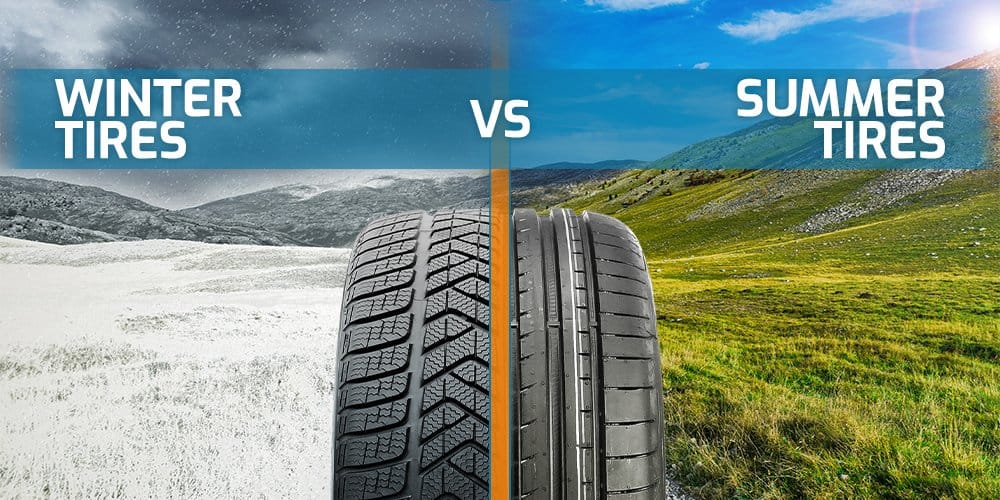When it comes to driving safety, tire selection plays a crucial role, especially in regions with distinct seasons. In the United States, where the weather can vary significantly from winter to summer, the choice between winter tires and summer tires can significantly impact your driving experience. This comprehensive guide will delve into the differences between these two tire types, providing valuable insights to help you make an informed decision for safer and more efficient driving.

Understanding the Purpose and Composition of Winter Tires and Summer Tires
Winter Tires
Winter tires, also known as snow tires, are specifically designed to enhance traction and control in cold, icy, and snowy conditions. They feature a unique rubber compound that remains flexible even at low temperatures, ensuring a better grip on slippery surfaces. Additionally, deep treads and unique siping patterns help channel away slush and snow for improved handling.
Summer Tires
On the other hand, summer tires, often referred to as performance tires, are engineered to deliver optimal performance in warm weather conditions. They are made of a harder rubber compound, which allows for better responsiveness, cornering, and braking on dry and wet roads. Summer tires also have shallower treads to maximize contact with the road, enhancing overall handling capabilities.
Key Differences between Winter Tires and Summer Tires
Let’s examine the core distinctions between these two tire types, which should guide your choice based on the prevailing weather conditions:
| Aspect | Winter Tires | Summer Tires |
|---|---|---|
| Temperature Range | Suitable for cold weather | Best for warm weather |
| Rubber Compound | Soft and flexible | Hard and less flexible |
| Tread Depth | Deeper treads | Shallower treads |
| Tread Pattern | More aggressive pattern | Less aggressive pattern |
| Performance on Snow | Excellent traction | Poor traction |
| Performance on Wet Roads | Good performance | Excellent performance |
| Performance on Dry Roads | Less responsive | Optimal responsiveness |
| Noise | Slightly noisier | Quieter |
| Wear and Tear | More wear in warm weather | Faster wear in cold weather |
| Recommended Usage | Winter and cold seasons | Spring, summer, and fall |
Winter Tires: Advantages and Disadvantages
Advantages
- Enhanced traction on snow and ice, reducing the risk of skidding.
- Improved braking performance, reducing stopping distances on icy roads.
- Increased confidence and control during winter driving.
- Better protection against hydroplaning in slushy conditions.
Disadvantages:
- Reduced performance and handling on dry and warm roads.
- Slower acceleration due to the softer rubber compound.
- Increased wear and tear during warmer months, leading to a shorter lifespan.
- Higher rolling resistance, impacting fuel efficiency.
Summer Tires: Advantages and Disadvantages
Advantages:
- Superior handling and responsiveness on dry and wet roads.
- Enhanced cornering capabilities, providing a sportier driving experience.
- Better fuel efficiency due to lower rolling resistance.
- Longer lifespan when used in the appropriate seasons.
Disadvantages:
- Poor performance on snowy and icy surfaces, potentially leading to accidents.
- Reduced traction and braking ability on cold and slippery roads.
- Increased road noise compared to winter tires.
- Prone to hydroplaning in heavy rain conditions.
Making the Right Choice: Factors to Consider
Climate and Driving Conditions:
Assess the prevailing weather conditions in your region and consider the frequency of extreme winter conditions.
Driving Habits and Routes:
Evaluate your daily driving routes and determine whether they are predominantly urban or rural, as well as the length of your commute.
Budget and Convenience:
Compare the costs of winter and summer tires, including potential expenses for seasonal changes and storage.
All-Season Tires as a Compromise:
Consider all-season tires if your region experiences mild winters and summers, as they offer a balance of performance in both conditions.
Conclusion
Choosing between winter tires and summer tires is a decision that significantly impacts your driving safety and performance. Each type has its unique advantages and disadvantages, making it essential to assess your specific needs and driving conditions before making a final choice. Regardless of your decision, prioritize safety and ensure regular tire maintenance to maximize the lifespan and performance of your chosen tires. Stay safe on the roads by making an informed tire choice for each season.